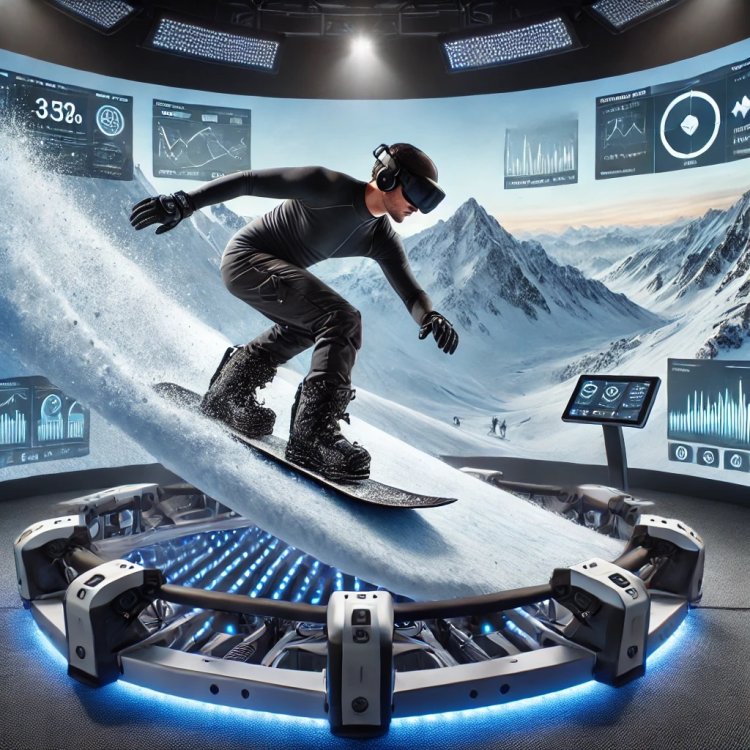The Greatest Snowboarding Simulator: Changing the Training of Athletes
Experience cutting-edge snowboarding simulators for year-round training. Improve skills, track performance, and explore advanced tech at our simulator showroom.
This game is the most intelligent and thrilling sport that demands mastering skills, balance, and precision. Due to inappropriate weather conditions, accessibility to suitable terrain, and injury risk, training in a real environment is limited. Such conditions are overcome through snowboarding simulators that act as cutting-edge solutions for athletes to learn and improve in a controlled environment.
What is Snowboarding Simulator?
An advanced training system designed to replicate real-world snowboarding experiences is a snowboarding simulation. Such simulators incorporate motion platform, virtual reality (VR) environments, and responsive surfaces to simulate the experience of riding onto snow. Such sophisticated sensors and an AI-driven analytics platform allow the athlete to optimize technique, balance, and real-time feedback.
Ideal Features of a Simulator for Snowboarding
1. Realism in Arena Simulation: Modern simulators prove capable of simulating powder, icy slopes, and moguls alike.
2. Virtual Reality Integration: Athletes now feel themselves in immersive VR scenarios embedded with reaction time and muscle memory as if they were alongside their peers in real action.
3. Adjustable Levels of Difficulty: A vast level of skill, from novice to advanced, is covered by the adaptation of the simulation experience.
4. Injury Prevention: Unlike real slopes, a simulator creates a safe environment for practice and error correction without risking severe injury.
5. Performance Analytics: Internal sensors track movements, weight distributions, stances, among other things, thus giving the athletes a one-step ideal performance analysis.
The Advantages Snowboarders Enjoy from Using a Simulator for Snowboarding
• Right Through the Year: The winter wait is over. The athlete is free to train at any time.
• Methodology Development: Focused training on turns, jumps, and carving without distractions.
• Stamina Development: Build up your endurance with a constant training practice, or better yet, improve your conditioning and physical makeup.
• Instant Feedback: Provide immediate corrective feedback to improve learning efficiency and technique improvement.
• Personalised Training Programs: Athletes can make their own programs and practice on precisely what they want to improve in their technique, whether that's carving, speed control, or tricks in the air.
• Psychological Training: Many simulators offer game-type challenges and competitive situations that build resilience and quick response in decision-making.
The Role of Simulator Showrooms
This goes a very long way in ensuring that the technology becomes accessible to the regular athlete as well as his professional counterpart. These showrooms also have practical experiences where a user can test out different models, get expert advice, and try out various training programs tailored to fit the individual user's requirements.

Choosing the Right Snowboarding Simulator
Various models available in the market make it a multifaceted decision to select the right simulator based on such criteria as budget, training aims, and technology preferences. Some simulators target casual users, while others serve the interests of professional athletes and sports academies. Important considerations include:
• Motion Accuracy: Providing a realistic feel of movements correspondingly detailing the actual snowboarding trainings.
• Software Capabilities: AI coaching, VR environment, and multiplayer training modes are some options to check for.
• Strength and Maintenance: You want durable but good simulators that withstand massive hours of training.
• Wearable Tech Integration: Integration with smartwatches and biometric sensors to monitor heart rates, muscle engagement-based feedback, and caloric burn is available in several advanced systems.
The Future of Snowboarding Simulators
With advancements in technology, the future of snowboarding simulators looks bright. AI, AR, and haptic feedback innovations will take immersion and effectiveness to the next level. Future prospects may include:
• AI-Enhanced Coaching: AI-manipulated personalized training plans based on performance data of the athlete.
• Online Training Multiplayer: Athletes could connect with other snowboarders all over the world to compete or train together in virtual environments.
• Portable Simulators: Compact models that allow athletes to train in their houses or limited spaces without compromising on functionalities.
• Real-Time Biomechanics: An advanced snowboarding simulator capable of analyzing an athlete’s posture, balance, and movements in real-time through motion capture technology gives very specific corrective feedback.
Conclusion
For snowboarders aiming to improve their game, time spent on a snowboarding simulator could be the key to mastering the slopes like never before. Whether in preparation for a competition or simply honing skills, simulators are completely unparalleled in training. Combining advanced technology and real-world physics, they provide athletes a space for safely and effectively pushing their limits.
With simulator showrooms making this technology increasingly available, it is the perfect time to delve into the many advantages of virtual snowboarding training. Snowboarding simulator: a definite game-changer in your excellence journey downhill, for professional athletes as well as those that have the heart of snowboarding.
What's Your Reaction?

















.jpg)
.jpg)


